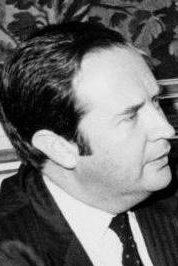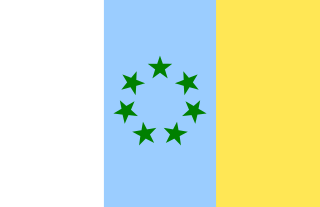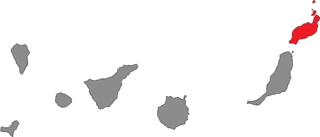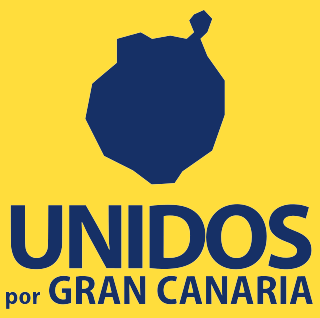Related Research Articles

The Canarian Coalition is a regionalist, Canarian nationalist political party in Spain operating in the Canary Islands. The party's aim is for greater autonomy for the islands but not independence. It has been labeled as centrist and liberal. The party governed the Canary Islands from 1993 to 2019; and currently since 2023 under Fernando Clavijo Batlle's leadership.
Miguel Cabrera Cabrera is a Spanish architect and politician whose sphere of political action has been the Canary Island of Fuerteventura.

The 1983 Canarian regional election was held on Sunday, 8 May 1983, to elect the 1st Parliament of the Autonomous Community of the Canary Islands. All 60 seats in the Parliament were up for election. The election was held simultaneously with regional elections in twelve other autonomous communities and local elections all throughout Spain.

The 1995 Canarian regional election was held on Sunday, 28 May 1995, to elect the 4th Parliament of the Autonomous Community of the Canary Islands. All 60 seats in the Parliament were up for election. The election was held simultaneously with regional elections in twelve other autonomous communities and local elections all throughout Spain.

The 2007 Canarian regional election was held on Sunday, 27 May 2007, to elect the 7th Parliament of the Autonomous Community of the Canary Islands. All 60 seats in the Parliament were up for election. The election was held simultaneously with regional elections in twelve other autonomous communities and local elections all throughout Spain.

The Nationalist Canarian Initiative, initially called Canarian Initiative, was a nationalist political party in the Canary Islands founded in 1991.

The Canarian Independent Groups were a Spanish political party based in the Canary Islands that existed from 1985 until its integration in Canarian Coalition.
Canarian Nationalist Federation was an electoral alliance in the Canary Islands, formed by the Canarian Nationalist Party (PNC), Independents of Fuerteventura (IF) and Lanzarote Independents Party (PIL) ahead of the 1999 Canarian election.

El Hierro is one of the seven constituencies represented in the Parliament of the Canary Islands, the regional legislature of the Autonomous Community of the Canary Islands. The constituency currently elects 3 deputies. Its boundaries correspond to those of the island of El Hierro. The electoral system uses the D'Hondt method and a closed-list proportional representation, with a minimum threshold of fifteen percent in the constituency or four percent regionally.

Fuerteventura is one of the seven constituencies represented in the Parliament of the Canary Islands, the regional legislature of the Autonomous Community of the Canary Islands. The constituency currently elects 8 deputies. Its boundaries correspond to those of the island of Fuerteventura. The electoral system uses the D'Hondt method and a closed-list proportional representation, with a minimum threshold of fifteen percent in the constituency or four percent regionally.

Gran Canaria is one of the seven constituencies represented in the Parliament of the Canary Islands, the regional legislature of the Autonomous Community of the Canary Islands. The constituency currently elects 15 deputies. Its boundaries correspond to those of the island of Gran Canaria. The electoral system uses the D'Hondt method and a closed-list proportional representation, with a minimum threshold of fifteen percent in the constituency or four percent regionally.

La Gomera is one of the seven constituencies represented in the Parliament of the Canary Islands, the regional legislature of the Autonomous Community of the Canary Islands. The constituency currently elects 4 deputies. Its boundaries correspond to those of the island of La Gomera. The electoral system uses the D'Hondt method and a closed-list proportional representation, with a minimum threshold of fifteen percent in the constituency or four percent regionally.

Lanzarote is one of the seven constituencies represented in the Parliament of the Canary Islands, the regional legislature of the Autonomous Community of the Canary Islands. The constituency currently elects 8 deputies. Its boundaries correspond to those of the island of Lanzarote. The electoral system uses the D'Hondt method and a closed-list proportional representation, with a minimum threshold of fifteen percent in the constituency or four percent regionally.

La Palma is one of the seven constituencies represented in the Parliament of the Canary Islands, the regional legislature of the Autonomous Community of the Canary Islands. The constituency currently elects 8 deputies. Its boundaries correspond to those of the island of La Palma. The electoral system uses the D'Hondt method and a closed-list proportional representation, with a minimum threshold of fifteen percent in the constituency or four percent regionally.

Tenerife is one of the seven constituencies represented in the Parliament of the Canary Islands, the regional legislature of the Autonomous Community of the Canary Islands. The constituency currently elects 15 deputies. Its boundaries correspond to those of the island of Tenerife. The electoral system uses the D'Hondt method and a closed-list proportional representation, with a minimum threshold of fifteen percent in the constituency or four percent regionally.

United for Gran Canaria is a Canary Island-based political party founded by former People's Party leader in Gran Canaria José Miguel Bravo de Laguna. Ahead of the 2015 Canarian regional election, it ran in the United electoral alliance formed by Nationalist Canarian Centre, Citizens for Change, Commitment for Gran Canaria, Lanzarote Independents Party, Majorero Progressive Party, Democratic and Progressive Party and Independent Group of Moya.
The Agreement of Nationalist Unity, frequently known under the name of its constituent parties, Canarian Coalition–Canarian Nationalist Party, was a permanent Canarian nationalist alliance formed by Canarian Coalition (CC) and Canarian Nationalist Party (PNC) in 2006 ahead of the 2007 Canarian regional election. The alliance has been renewed several times, in 2011, 2013 and 2018. For the 2011 and November 2019 general elections it was joined by New Canaries (NC). The alliance was dissolved in 2023, with the PNC arguing that the CC had now « nothing of nationalist »
The 1983 Canarian Island Cabildo elections were held on Sunday, 8 May 1983, to elect the 2nd Island Cabildos of El Hierro, Fuerteventura, Gran Canaria, La Gomera, La Palma, Lanzarote and Tenerife. All 137 seats in the seven Island Cabildos were up for election. The elections were held simultaneously with regional elections in thirteen autonomous communities and local elections all throughout Spain.
The Herrenian Assembly is a regionalist and Canarian nationalist political party in El Hierro. AH was created in 2019 as the For El Hierro Electoral Group by David Cabrera de León, a former member of the Independent Herrenian Group.
References
- ↑ "Asamblea Majorera llega a los cuarenta con su perfil progresista vivo". Canarias en Hora (in Spanish). 16 December 2017. Archived from the original on 18 July 2016. Retrieved 13 January 2018.
- ↑ "Historia de Asamblea Majorera – Coalición Canaria en Fuerteventura". ccfuerteventura.com (in Spanish). Retrieved 13 January 2018.